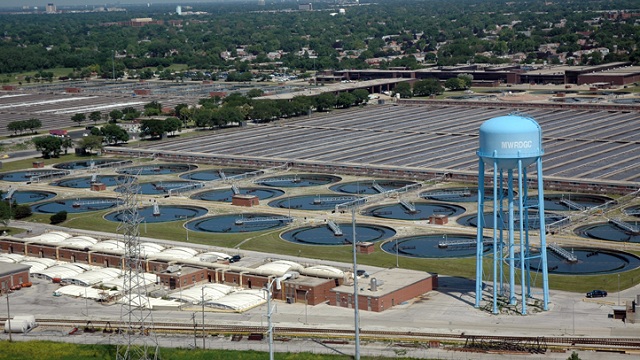Chicago and its outlying suburbs create 5 billion litres of wastewater every day. As this isn’t the 1880s anymore and you can’t just let the effluence run back into a lake, you have to clean it. Here. At the biggest wastewater treatment plant on Earth.
The Stickney Water Reclamation Plant is located on 230 hectares of Cicero, just southwest of Chicago. That’s big enough to warrant having its own railway — which it does. Processing upwards of 4.5 billion litres per day (up from 2.9 billion litres/day in 2008), it serves 2.38 million people over 673km2 including central Chicago and 43 suburban communities. It is one of six wastewater treatment plants and 23 pumping stations in the Metropolitan Water Reclamation District of Greater Chicago (MWRDGC). The Sanitary District has seven sectors, each delivering their bounty to one of the seven treatment plants via the sewers.
The MWRDGC is also charged with maintaining approximately 122km of waterways in the Chicago Sanitary and Ship Canal, which connects the Atlantic Ocean and Great Lakes with the Mississippi River and Gulf of Mexico.
The full Stickney facility is split into two plants — a western plant which entered service in 1930 and a southwest portion that opened nine years later. Stickney’s maximum capacity is 5.2 billion litres (though it regularly operates at a lower rate) if all 166 processing tanks are in use. Needless to say, keeping an operation like this flowing smoothly isn’t nearly as easy as flushing the loo.
When wastewater enters the plant at one of two locations, the first phase physically removes contaminants, screening debris that might clog the machines down-flow — either large non-biological items or stuff like sand and grit. These materials are dumped in a sanitary landfill after being washed.
The water then flows into a primary settling tank where most of the heavier solids slowly sink to the bottom while oils, grease, and lighter waste float to the top. In these tanks, revolving skimmers continually collect the solid waste at the bottom and the oily film on the top.
The second phase employs a series of tanks and a rather large population of micro-organisms. These bacteria feast upon the remaining biological compounds and convert the waste into a form that’s easier to separate from the water. The first tanks are aerated to provide sufficient oxygen for the microbes to grow, eat and multiply.
The second tank separates the bacteria culture from the treated water. Here the bacteria clump together and sink to the bottom, where they are removed. 85 per cent of these cultures are then recycled to seed the next batch of cleaning tanks.
From here the treated water is either discharged to the Sanitary and Ship Canal, or, if officials want to get the last five per cent of poo out of the wastewater, it’ll go to the third stage of cleaning.
During the tertiary phase, the water is further filtered, ammonia and other specific contaminants are removed, and sometimes bacteria are destroyed that may cause human fatalities. According to the MWRDGC, 95-percent-clean water can actually be deposited into a river or stream without any adverse environmental impacts and that this water is even cleaner than the river water it’s being dumped into (note to self: don’t drink from Chicago-area streams). In all, the entire cleaning process takes a bit less than 12 hours.
Now, what to do with all of that crap that was mechanically removed in phase one? Those bio-solids, more politely known as sludge or residuals, are first broken down in huge anaerobic digestion tanks. They are then centrifugally separated from any remaining water, then dried “and aged” in large outdoor beds. Finally, the poo sheets are hauled off to be recycled.
Golf courses, sod farms, street medians and parks all use bio-solids to maintain their lush covering (remember that when you’re rolling around in Lincoln Park). Fulton County’s Sanitary District actually reclaimed 6070 hectares that had previously been a strip mine by levelling the area and “spiking” the barren soil with sludge to reintroduce nutrients into the soil. The land is now used for agriculture.
[Water-Technology – Water and Wastewater – Aiche.org – The centre for Land Use Interpretation – Metropolitan Water Reclamation District – Tapped Water]
